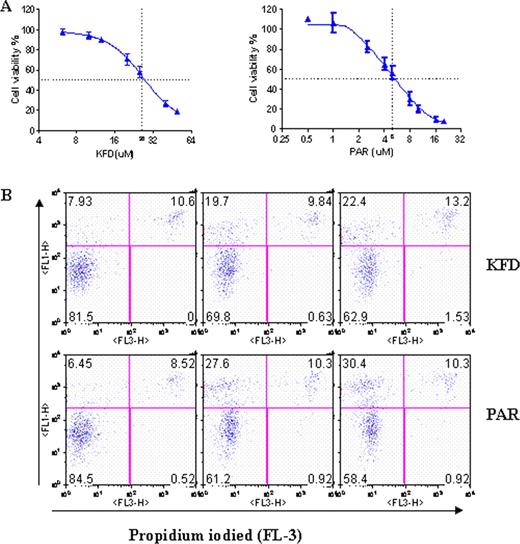Abstract
Abstract 5029
Multiple myeloma (MM), cancer of the plasma cells, remains incurable despite advancement in therapeutic regiments. Studies showed that the ‘side population (SP)’, a subpopulation enriched with CSC in various cancers, has higher drug transporter activity than the bulk tumor; suggesting the reason why these cells survived despite post-chemotherapy. The increasing evidence of cancer stem cells (CSC) suggests that anti-cancer drugs targeting this subpopulation may lead to eradication of the root of cancer recurrence. In this study, we explored the capability of kaempferide (KFD), a flavanoid in propolis (bee glue) that can reverse drug transporter activity, to combat SP cells in myeloma. KFD was one of the compounds in Brazilian propolis that reduced SP percentage in myeloma cell lines. We report for the first time that KFD is able to induce apoptosis in the SP cells in myeloma. The ability of KFD to inhibit growth of unfractionated KMS-11 cells was first investigated. Parthenolide (PAR), a natural product shown to inhibit growth of putative CSC in acute and chronic myelogenous leukemia was included as control. Unfractionated cells were seeded at 20000 cells per well in a 96 well plate. After 24h of incubation with various concentration of KFD, PAR, and DMSO (vehicle control), MTS solution was added and absorbance at 490 nm was determined. The IC50 of KFD and PAR in KMS-11 cells was 26 μM and 5 μM with 95% confidence intervals between 17.7 to 33.3 μM and 4.0 to 5.8 μM respectively. This is shown in the dose-response curve in figure 1A. No significant growth inhibition was observed in DMSO (0.1% to 0.5 % v/v) treated cells. We then examined if the KFD causes apoptosis in the sorted-SP cells. Sorted-SP cells were treated with 26 μM KFD, 5 μM PAR, or 0.2% v/v DMSO as mentioned above. After 1, 3, and 6 hour of incubation, cells were harvested and stained with Annexin V and propidium iodide and then analyzed using FACS Calibur. Result showed that percentage of Annexin V+ apoptotic cells in KFD-treated cells increased in a time series manner (1, 3, 6 h) (figure 1B). Because KFD was reported to be capable to reverse the activity of drug efflux transporter, further studies to investigate the synergistic effect of KFD with conventional drugs to treat myeloma will be carried out. Alternative medicines employing natural products have become increasingly sought after when conventional drugs cause immense side effects. Component in propolis that was reported to have anti-cancer properties, has low toxicity at high concentration, and spare normal cells, appeals to be a potential compound to combat myeloma. Exploitation of KFD that has the dual effect to induce apoptosis in putative CSC in myeloma and reverse drug transporter activity offers great opportunity in cancer drug development and future clinical trials in patients with myeloma.
A
B
Annexin V-FITC (FL-1)
Propidium iodied (FL-3)
(A) Growth inhibition by KFD and PAR after 24h of incubation. Experiment was repeated at least 3 times. (B) KFD induced apoptosis in KMS-11 in a time-series manner. Cells were treated with 26 μM KFD or 5 μM PAR for 1, 3, and 6 hour and was stained with Annexin V and propidium iodide.
KFD
PAR
(A) Growth inhibition by KFD and PAR after 24h of incubation. Experiment was repeated at least 3 times. (B) KFD induced apoptosis in KMS-11 in a time-series manner. Cells were treated with 26 μM KFD or 5 μM PAR for 1, 3, and 6 hour and was stained with Annexin V and propidium iodide.
KFD
PAR
No relevant conflicts of interest to declare.
Author notes
Asterisk with author names denotes non-ASH members.



This feature is available to Subscribers Only
Sign In or Create an Account Close Modal